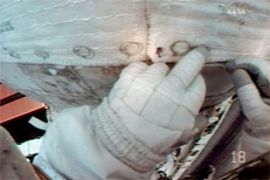Progress made on Nasa space repairs
Astronauts repair shuttle insulation and four space station computers.

The US space shuttle is expected bring the two boxes that are still malfunctioning back to Earth and the Russians will take replacements up on a later mission of their own.
Critical systems
Friday’s news was the most optimistic since the computers linked to the Russian segment of the 16-nation International Space Station crashed on Wednesday.
The computers control the station’s positioning in space so it can draw power from the sun, maintain proper temperatures and position antennas for communicating with ground controllers.
The German-built computers also command critical life-support equipment, such as the oxygen generators and scrubbers that remove deadly carbon dioxide. Those machines can be manually controlled as well.
Russian engineers have determined that one or two of the systems’ backup power supplies have failed. Persistent failure with the computers could have forced the temporary evacuation of the space station.
The computer crash was not considered life-threatening to either the station or shuttle crews.
Third spacewalk
Two Nasa astronauts, James Reilly and John “Danny” Olivas, completed the third spacewalk since Atlantis arrived at the space station on Sunday as the machines soared over West Africa. The spacewalk lasted almost eight hours.
The spacewalkers’ most crucial task was repairing a protruding piece of insulation into an engine pod near the rear of the spaceship.
| “This is one of the most complex engineering tasks ever achieved in the history of mankind”
Francisco Diego, space expert from University College London |
The corner flap of a blanket tore loose during Atlantis’ climb to orbit last Friday.
While the exposed gap is not believed to pose a heat shield breach akin to the Columbia disaster in 2003, managers said repairing the damage would protect the shuttle’s underlying structure from weakening during the scorching plunge through the atmosphere.
A breach in shuttle Columbia‘s wing, caused by a debris impact during launch, triggered the spaceship’s breakup over Texas on February 1, 2003. All seven astronauts aboard died.
The astronauts also successfully coaxed a bulky solar wing back into its storage box.
A milestone on this mission will be reached at 05:47 GMT when Sunita Williams will break the record for the most time spent in space by a woman. She will have spent 188 days and fours hours in space, eclipsing the record set by fellow American Shannon Lucid.
Williams travelled to the space station on the previous shuttle mission in December and is scheduled to return with the shuttle to Earth next week.
Enormous complexity
Francisco Diego, a space expert from University College London, told Al Jazeera that while the problems faced on the mission will be a temporary setback for the space station, they are to be expected given the complexity of the project and the difficult working conditions astronauts face in a limited amount of time.
He said: “This is one of the most complex engineering tasks ever achieved in the history of mankind.”
“There are so many systems and different nations contributing to the station … so the complexity is enormous and I think we would expect problems like this in the future.”
Diego said in a way it was fortunate the computer failure occurred while the extra astronauts from Atlantis were around.
He also said he thought the space station would be completed on time and would be a “major achievement”.